IF a,A,b are in Arithmetic progression, then prove that A=a+b2.Solution in Kannada
Step by step video & image solution for IF a,A,b are in Arithmetic progression, then prove that A=(a+b)/2. by Maths experts to help you in doubts & scoring excellent marks in Class 10 exams.
Updated on:21/07/2023Topper's Solved these Questions
- ARITHMETIC PROGRESSIONSBOOK - OSWAAL PUBLICATIONCHAPTER - ARITHMETIC PROGRESSIONSEXERCISE - LONG ANSWER TYPE QUESTION-I
11 Videos
- ARITHMETIC PROGRESSIONSBOOK - OSWAAL PUBLICATIONCHAPTER - ARITHMETIC PROGRESSIONSEXERCISE - LONG ANSWER TYPE QUESTIONS-II
13 Videos
- ARITHMETIC PROGRESSIONSBOOK - OSWAAL PUBLICATIONCHAPTER - ARITHMETIC PROGRESSIONSEXERCISE - VERY SHORT ANSWER TYPE QUESTION
8 Videos
- AREAS RELATED TO CIRCLES BOOK - OSWAAL PUBLICATIONCHAPTER - AREAS RELATED TO CIRCLES EXERCISE - LONG ANSWER TYPE QUESTIONS - I
20 Videos
- CIRCLES BOOK - OSWAAL PUBLICATIONCHAPTER - CIRCLES EXERCISE - TEXTBOOK CORNER (EXERCISE 4.2)
13 Videos
Similar Questions
Find the sum of all natural numbers between 200 and 300 which are divisible by 6.
View SolutionThe sum of four consecutive terms which are in an arithmetic progression is 32 and the ratio of the product of the first and the last term to the product to two middle terms is 7:15. Find the number.
View SolutionWhat is the common difference between the consecutive terms of an A.P.
View SolutionIn the given figure, AOB is a sector of angle 60∘ of a circle with centre O and radius 17 cm . If AP ⊥ OB and AP = 15 cm find the area of the shaded region.

View SolutionFrom a point Q ,the length of the tangent to a circle is 24 cm and the distacne to Q from the centre is 24.5 cm.The radius of the circle is
(a) 4.92 cm
(b)12 cm
©15 cm
(d)24.5 cm
View SolutionIf the numbers a,x,y,b are in arithmetic progression and the numbers c^3 , x,y, d^3 are in geometric progression then prove that a+ b = cd ( c+d)
View SolutionIn DeltaABC if sinA.sin(B-C)= sinC.sin(A-B),then-(A!=B!=C) (A) tanA, tanB, tanC are in arithmetic progression (B) cotA, cotB, cotC are in arithmetic progression (C) cos2A, cos2B, cos2C are in arithmetic progression (D) sin2A. sin2B. sin2C are in arithmetic progression
View SolutionIf x, y, z are in arithmetic progression and a is the arithmetic mean of x and y and b is the arithmetic mean of y and z, then prove that y is the arithmetic mean of a and b.
View Solution(a) The nth term of a progression is (3n+5). Prove that this progression is an arithmetic progression. Also find its 6th term. (b) The nth term of a progression is (3−4n). Prove that this progression is an arithmetic progression. Also find its common difference. (c) The nth term of a progression is (n2−n+1). Prove that it is not an A.P.
View SolutionIf a,bandc are in arithmetic progression, then b+c,c+aanda+b are in
View SolutionIf a,bandc are positive numbers in arithmetic progression and a2,b2andc2 are in geometric progression, then a3,b3andc3 are in
(A) arithmetic progression.
(B) geometric progression.
(C) harmonic progression.
View SolutionIf the roots of (a−b)x2+(b−c)x+(c−a)=0 are real and equal, then prove that b, a, c are in arithmetic progression.
View SolutionIf a, b, c are in geometric progression, and if a1x=b1y=c1z, then prove that x, y, z are in arithmetic progression.
View Solutionlet a<b, if the numbers a,b and 12 form a geometric progression and the numbers a,b and 9 form an arithmetic progression , then (a+b) is equal to:
View SolutionIf a,b,c are in geometric progression and if a1x=b1y=c1z, then prove that x,y,z are in arithmetic progression.
View Solution
